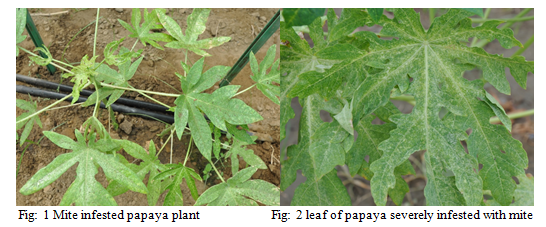Authors: Dr Jai Prakash, Kanhaiya Singh and A. K. Goswami
Division of Fruits and Horticultural Technology
ICAR-Indian Agricultural Research Institute, New Delhi-12
* Corresponding author email: singhjai2001@rediffmail.com
Papaya experience short growing season, unfavorable climatic conditions (too cold, too hot, too dry and cloudy ambient) impairing photosynthetic activities, vulnerable to predators, pests, weeds, depleted soil moisture and plant nutrients leading to drastic reduction in fruit yields. Infection of different viruses is becoming serious threat to papaya industry in India and we are unable to find out solution. Papaya is a shy crop towards the response of pesticides. The intervention of net house has reduced the movement of vectors of the viral disease and pests like fruit flies. The papaya crop is damaged due to frost in the northern part of India which can be protected under greenhouse cultivation. The cultivation of papaya in polyhouse/nethouse has given the hope of virus free fruit production but simultaneously mite has been observed as major destructive pest. The management of mite’s also inviting heavy pesticide load on the product. The present article is an effort to sensitize the mite problem in polyhouse cultivation of papaya and their management.
Mite infestation symptoms
Red spider mite is one of the most troublesome pests of papaya under greenhouse and sometime in open field as well. It is a sap-sucking mite that attacks on the foliage of plants, causing a mottled appearance, and in severe cases, leaf loss and even plant death. Glasshouse red spider mite thrives in warm, dry conditions, so is usually only a problem from March to October. It will also cause problems outdoors in summer, especially in hot, dry weather. Mite is spread damage rapidly during the summer month in polyhouse. A fine pale mottling on the upper leaf surface, the underside of the leaves have many tiny yellowish green mites and white cast skins and egg shells. Mites are easily visible from naked eyes, therefore use of magnifying lenses (10x) are important to identify them. Heavily infested plants are severely weakened and may die.
Management
Remove severely infested plants from glasshouses in late summer before lower temperatures and shorter days induce the females to seek sheltered places where they will remain dormant for the winter period. Plants grown at high temperatures in dry, overcrowded glasshouses are more liable to severe infestation. Regular syringing of plants with clear water and maintaining a high humidity reduce the danger of severe attacks, but will not on its own control this pest. A predatory mite (Phytoseiulus persimilis) feeds on the eggs and active stages of polyhouse red spider mite. It needs good light and daytime temperatures of 21°C (70°F) or more if it is to breed faster than the pest. As the predator is susceptible to pesticides, biological control cannot be used in conjunction with most chemical controls. Phytoseiulus persimilis will not control other species of red spider mite. Applications of spiromesifen 22.9% @ 1.5 ml/liter of water control the mites’ infestation effectively. These pesticides has their residue effects, its application has to be last option and precisely. The frequent applications of such pesticide may be avoided, otherwise mites has the ability to develop resistance against those molecules.

About Author / Additional Info:
I am working as a senior scientist at IARI New Delhi.